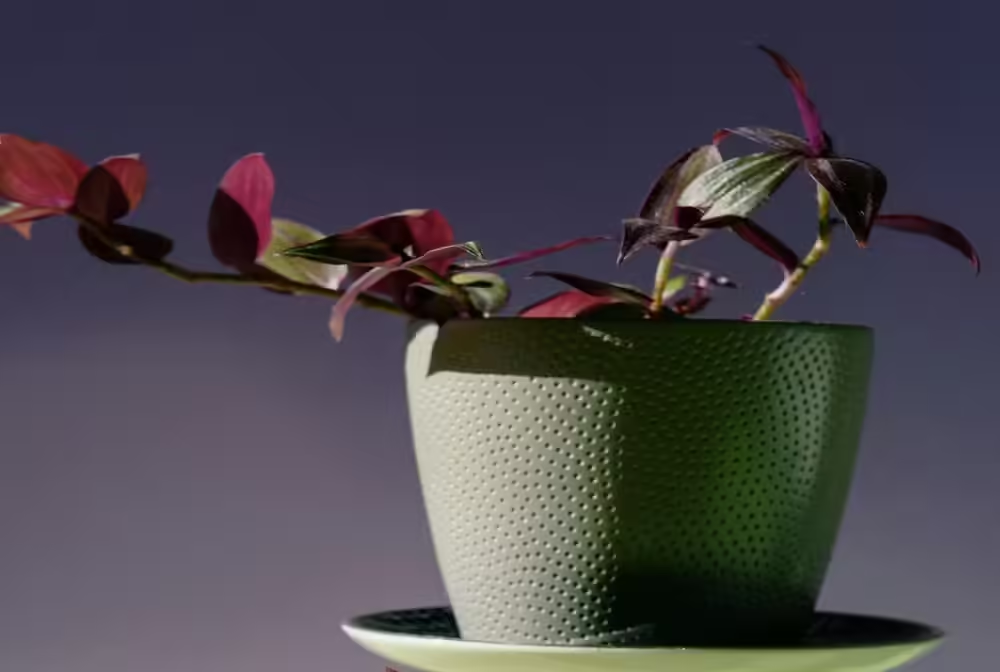If you’re searching for a low-maintenance plant that stands out, learning about Tradescantia Zebrina care might lead you to your new favorite indoor plant.
With its striking purple and silver-striped leaves, this trailing beauty is sure to bring a pop of color to any space.
Whether you’ve already propagated it (check out our post on that) or are just starting your green journey, knowing how to care for this plant properly is key to keeping it thriving.
In this guide, we’ll dive into everything you need to know about Tradescantia Zebrina care, so you can enjoy its vibrant hues year-round.
Origin and Profile of Tradescantia Zebrina
Tradescantia Zebrina, commonly known as Inch Plant or Wandering Jew, is native to Mexico and Central America, where it thrives in warm, tropical environments.
The plant gets its name from the pattern on its leaves—beautiful streaks of silver that alternate with purple or green. It’s a fast-growing, trailing plant that looks stunning in hanging baskets or as a cascading addition to your indoor plant collection.
This plant grows quickly, which means it’s easy to propagate and share with friends. Its trailing nature also makes it a great choice for shelves, balconies, or windowsills where its stems can spill over the edges, creating a lovely visual display.
Tradescantia Zebrina Care: Complete Guide
Taking care of Tradescantia Zebrina is relatively simple, making it a popular choice for both beginner and experienced plant parents. Here’s a comprehensive guide to keeping your Tradescantia Zebrina healthy and thriving indoors:
- Light:
Tradescantia Zebrina thrives in bright, indirect light. It can tolerate lower light levels, but its vibrant colors may fade if it’s not getting enough light. Avoid direct sunlight, as this can scorch its delicate leaves. Ideally, place it near a north or east-facing window. - Watering:
The plant prefers moderately moist soil. Be sure to allow the top inch or two of soil to dry out between waterings, as overwatering can lead to root rot. However, don’t let it stay dry for too long, especially during its growing season in spring and summer. - Humidity & Temperature:
Coming from tropical regions, this plant loves humidity. If your home is on the dry side, especially during the winter, consider misting the plant or placing it near a humidifier. The ideal temperature range for Tradescantia Zebrina is 60-80°F (15-27°C). - Soil:
Well-draining potting soil is crucial for this plant. A mix designed for tropical plants, with some added perlite or sand, will ensure proper drainage and help prevent root rot. - Fertilizing:
During its growing season (spring and summer), feed your Tradescantia Zebrina monthly with a balanced, water-soluble fertilizer. Cut back on fertilizing during the fall and winter when the plant is not actively growing. - Pruning:
Tradescantia Zebrina is a fast grower and can become leggy over time. Regular pruning will help keep the plant full and bushy. Pinch back the stems to encourage new growth, and don’t hesitate to propagate the cuttings!
Frequently Asked Questions
1- Can Tradescantia Zebrina grow in water?
Yes, Tradescantia Zebrina can absolutely grow in water! In fact, water propagation is one of the easiest ways to multiply this plant. If you’re curious about how to do it, check out our detailed guide on propagating Tradescantia Zebrina in water.
2- Is Tradescantia Zebrina toxic to cats and dogs?
Unfortunately, yes. According to the ASPCA, Tradescantia Zebrina is toxic to cats, dogs, and even horses. If you have pets, it’s essential to keep this plant out of their reach, as ingestion can lead to skin irritation and other health issues.
3- Can Tradescantia Zebrina grow outside?
Yes, but only in mild climates. Tradescantia Zebrina cannot survive freezing temperatures or cold winters, so if you live in a cooler region, it’s best to keep this plant indoors.
4- Does Tradescantia Zebrina flower?
While Tradescantia Zebrina can flower, it’s quite rare when grown indoors. The good news is that its vibrant, colorful leaves are so decorative that you might not miss the flowers! In a hanging basket, the plant’s trailing stems create a stunning, almost floral display on their own.
5- Is Tradescantia Zebrina a succulent?
No, but it does share some similarities. Tradescantia Zebrina is not a true succulent, but its thick stems and leaves help it retain moisture, allowing it to survive periods of drought.
6- How to prune Tradescantia Zebrina?
Pruning Tradescantia Zebrina is simple and helps keep the plant vibrant. Just pinch or cut back the leggy stems right above a leaf node to encourage new growth. This not only keeps the plant bushy but also prevents it from becoming too long or scraggly. Bonus: You can even propagate the cuttings for more plants!
7- How to repot Tradescantia Zebrina?
Repotting Tradescantia Zebrina is like giving it a fresh start. When the roots outgrow the pot, usually every year or two, choose a slightly larger pot with good drainage. Gently remove the plant, shake off excess soil, and place it in fresh, well-draining soil. Give it a good drink, and your Zebrina will be ready to thrive again!
8- How to make Tradescantia Zebrina bushy?
If you want your Tradescantia Zebrina to look lush and full, the key is regular pruning. Pinch back the stems, especially if they start getting long or leggy. This encourages the plant to grow more side shoots, giving you that beautiful, bushy effect. More stems mean more vibrant leaves to enjoy!
Final Thoughts
Tradescantia Zebrina is a fantastic plant for anyone looking to add a touch of color and life to their indoor space.
Whether you’re new to plant care or a seasoned pro, this plant’s resilience and beauty make it a perfect choice. With the right balance of light, water, and occasional pruning, you’ll find it growing quickly and brightening your home in no time.
Remember, if you want to learn more about propagating Tradescantia Zebrina, don’t forget to check out our related post!

